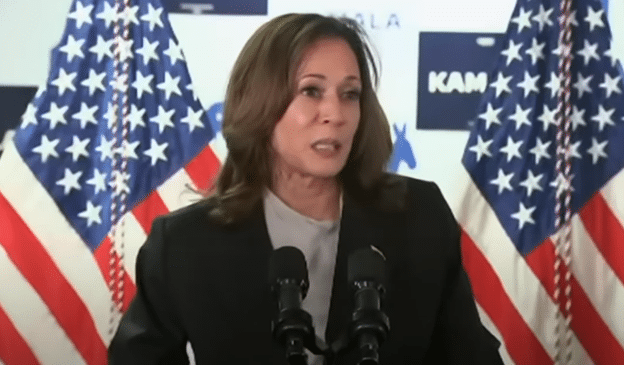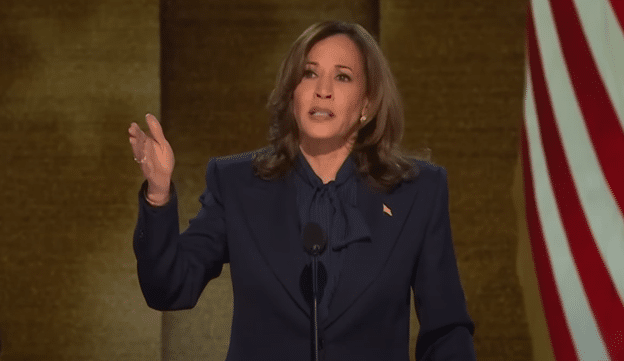
August 30, 2024
Permission to republish original opeds and cartoons granted.
A Huge Problem for Kamala Harris with Independents is Emerging
| 
|
|
There is a glaring issue for Kamala Harris this election cycle: independent voters. Around 41 percent of Americans currently identify as independent according to Gallup, and averaged around 43 percent in 2023, and by all accounts, they are not fans of Harris, with new polling data showing independents breaking for former President Donald Trump after supporting President Joe Biden by double-digits in 2020. Independent voters supported Biden over Trump by 13 percentage points, 54 percent to 41 percent in 2020 in the CNN exit poll and made up a full 26 percent of the voter pool. However, the latest YouGov poll reveals Harris will be lucky to win them by even a single percentage point – and she could lose them to Trump entirely. According to YouGov data released this week, independents plan to support Trump over Harris by five points, 42 percent to 37 percent, constituting a 17-point decline for Harris compared to what Biden got in 2020. |
Kamala Harris gets no bounce out of Democratic Convention, stays below 50 percent in national polls
| 
|
|
More post-Democratic National Convention and Robert Kennedy leaving the presidential race polls keep coming out with one consistent theme: Vice President Kamala Harris has not made the sale the American people and remains below 50 percent in national polls — which leaves the race wide open in November. So, where does Kamala Harris fall? Looking at Yahoo News, Reuters-Ipsos, Quinnipiac, Economist-YouGov, USA Today-Suffolk, Rasmussen, Wall Street Journal, and Morning Consult, taken during and after the Democratic National Convention, Harris averages 47.25 percent, while her opponent, former President Donald Trump is averaging 45.12 percent. In recent history, Al Gore got 48.4 percent of the national popular vote but barely lost the Electoral College to George W. Bush in 2000 and Hillary Clinton got 48.2 percent of the national popular vote in 2016 and similarly lost the Electoral College to former President Donald Trump. Whereas, Barack Obama got 53 percent of the popular vote in 2008 and 51 percent in 2012, and Joe Biden got 51 percent in 2020, and both won their contests, although Biden’s 43,000 vote margin in the swings states of Wisconsin (23,000), Georgia (10,000) and Arizona (10,000) saw one of the most closely contested races in history. With the recent polling, she appears to have more in common with Al Gore and Hillary Clinton than Barack Obama and Joe Biden. |
A Huge Problem for Kamala Harris with Independents is Emerging

By Manzanita Miller
For the last month, Democrats have been riding a high, celebrating the fact that for the first time this year they have a candidate running who appears to garner some level of enthusiasm. The Democratic National Convention celebrated Vice President Kamala Harris’s ascension to the top of the ticket, and the mainstream media lost no time favorably covering her campaign. In picking radical leftist Tim Walz as her Vice President, Harris further energized the America Last wing of the Democratic Party, and she appears to be is sailing on a wave of deep-pocketed Wall Street funding toward the finish line.
There is one glaring issue for Harris however – independent voters. Around 41 percent of Americans currently identify as independent according to Gallup, and averaged around 43 percent in 2023, and by all accounts, they are not fans of Harris, with new polling data showing independents breaking for former President Donald Trump after supporting President Joe Biden by double-digits in 2020.
Independent voters supported Biden over Trump by 13 percentage points, 54 percent to 41 percent in 2020 in the CNN exit poll and made up a full 26 percent of the voter pool. However, the latest YouGov poll reveals Harris will be lucky to win them by even a single percentage point – and she could lose them to Trump entirely.
According to YouGov data released this week, independents plan to support Trump over Harris by five points, 42 percent to 37 percent, constituting a 17-point decline for Harris compared to what Biden got in 2020.
Another poll from Roanoke College is causing a stir among Virginians, with former Gov. Terry McAuliffe expressing disbelief that Kamala Harris isn’t polling better against Trump with independents in the state. The poll, which was conducted before Robert F. Kennedy Jr. dropped out of the race and endorsed Trump, found that Harris is ahead of Trump by just three percentage points, with independents contributing significantly to Trump’s margins. Independents are planning to support Trump by 16 points, 50 percent to 34 percent in a two-way race according to the poll. Even with Kennedy on the ballot, independents planned to support Trump by 12 points over Harris.
This swing toward Trump is a massive shift from 2020, when Biden won Virginia independent voters by nearly twenty points, 57 percent to 38 percent. While Trump is ahead in Virginia so far according to the poll, Trump’s strong lead among independents is concerning to Democrats who know they need to appeal beyond their base to win. Independents, particularly those in rural areas, are reluctant to throw their support behind a candidate who stood beside Biden at the helm of the country for the past four grueling years.
Nationally, the share of Americans identifying as independent is on the rise. According to Gallup, again, 41 percent of the population identifies as independent today, much larger than the 30 percent who identify as Republican and the 28 percent who identify as Democrat.
The only other time in the past three decades when this many Americans have identified as independent was in 2014, when conservatives swept U.S. House races, securing a historic majority in the House. In the 2014 midterms, independents who were fed up with the Obama administration and the radical left’s trajectory flooded Republican House races and helped contribute to the largest number of House seats for Republicans since 1928. Independents supported Republican House candidates by a margin of 12 points nationwide.
The independent vote matters, and by most metrics Harris is falling short of Biden’s numbers. This isn’t a total surprise, given that her platform is catering to the most radical elements of the Democratic Party. Conservatives have their work cut out to beat Harris with the amount of institutional support and funding she has acquired, but there is a real opportunity to turn out independent voters who are not at all interested in her America Last agenda.
Manzanita Miller is the senior political analyst at Americans for Limited Government Foundation.
Kamala Harris gets no bounce out of Democratic Convention, stays below 50 percent in national polls

By Robert Romano
More post-Democratic National Convention and Robert Kennedy leaving the presidential race polls keep coming out with one consistent theme: Vice President Kamala Harris has not made the sale the American people and remains below 50 percent in national polls — which leaves the race wide open in November.
So, where does Kamala Harris fall?
Looking at Yahoo News, Reuters-Ipsos, Quinnipiac, Economist-YouGov, USA Today-Suffolk, Rasmussen, Wall Street Journal, and Morning Consult, taken during and after the Democratic National Convention, Harris averages 47.25 percent, while her opponent, former President Donald Trump is averaging 45.12 percent.
In recent history, Al Gore got 48.4 percent of the national popular vote but barely lost the Electoral College to George W. Bush in 2000 and Hillary Clinton got 48.2 percent of the national popular vote in 2016 and similarly lost the Electoral College to former President Donald Trump.
Whereas, Barack Obama got 53 percent of the popular vote in 2008 and 51 percent in 2012, and Joe Biden got 51 percent in 2020, and both won their contests, although Biden’s 43,000 vote margin in the swings states of Wisconsin (23,000), Georgia (10,000) and Arizona (10,000) saw one of the most closely contested races in history.
With the recent polling, she appears to have more in common with Al Gore and Hillary Clinton than Barack Obama and Joe Biden.
Diving into the latest Economist-YouGov poll taken Aug. 25 to Aug. 27, wherein Harris led Trump by 47 percent to 45 percent, compared to the last Economist-YouGov polls taken before the 2016 and 2020 elections shows that Trump has largely improved among almost every single age demographic since 2016.
Among 18-29-year-olds, in 2016, Hillary Clinton led by 30 points, 54 percent to 24 percent. In 2020, that fell to 17 points, with Biden leading Trump 49 percent to 32 percent. Today it stands at 19 points, with Harris leading 52 percent to 33 percent.
Overall, Trump has improved by 11 points among young people on the spread and by 9 points on the sheer number since he ran the first time, although Harris does slightly better than Biden did in 2020.
Among 30-44-year-olds, Clinton led Trump by 14 points, 49 percent to 35 percent, Biden led Trump by 21 points, 54 percent to 33 percent and Harris leads Trump by 15 points, 53 percent to 38 percent.
Among 45-64-year-olds, the largest group, Clinton led Trump by 1 point, 44 percent to 43 percent, Biden led Trump by 3 points, 47 percent to 44 percent and now Trump leads Harris by 5 points, 49 percent to 45 percent.
And among those 65-years-old-and-older, Trump led Clinton by 19 points, 56 percent to 37 percent, Biden led Trump by 4 points, 49 percent to 45 percent, and Trump now leads Harris by 12 points, 53 percent to 41 percent.
The juxtaposition is that Harris does slightly better than Biden on 18-29-year-olds (but far worse than Clinton), but worse than Biden on 30-44-year-olds, 45-64-year-olds and seniors as Trump’s standing in the Economist-YouGov poll has improved markedly.
Interestingly, Trump also leads Harris among independents by 5 points, 42 percent to 37 percent. In 2020, Biden led Trump among independents by 9 points, 48 percent to 39 percent, whereas in 2016, Trump led Clinton among independents by 13 points, 44 percent to 31 percent. There, once again, Harris fares worse than Biden, but better than Clinton.
The numbers have to be troubling to Democrats and the Harris campaign watching the race closely. Following the convention, Harris should be at her apex of popularity, but so far, the race hasn’t moved at all. Perhaps the lack of details and policy specifics isn’t helping.
In the meantime, Harris might indeed need a national majority to win, and right now, with no bounce coming out of her convention, she doesn’t have one. Stay tuned.
Robert Romano is the Vice President of Public Policy at Americans for Limited Government Foundation.
